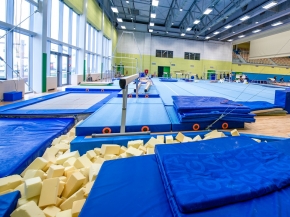Creating healthy gyms

Studies show U.S. collegiate gymnasts have disproportionately high exposures to toxic flame retardant chemicals, up to six times higher compared with the general population. And levels of flame retardants in dust at gym facilities are an order of magnitude higher than in other indoor spaces. Research points to the foam pits as an important source of exposure. Due to their semi-volatile properties, flame retardants can migrate out of the foam and accumulate in dust and deposit on people’s skin. Some of the flame retardant chemicals used in gymnastics training equipment are endocrine disrupting chemicals that have been shown to disrupt thyroid hormone signaling in the body. The chemicals have also been associated with other health effects including neurodevelopment problems, weight gain, infertility, and cancers.
Gymnasts are especially at risk because the majority of training occurs during childhood and adolescence—a stage in life when the body is vulnerable to chemical exposures. Competitive gymnasts also have intense practice schedules in the years preceding and immediately following puberty, spending 15 to 20 hours per week in the gym.
To address the issue, Silent Spring along with researchers at Michigan State University, Worcester Polytechnic Institute (WPI), and Tufts University conducted an intervention study. With funding from the Toxics Use Reduction Institute (TURI), they replaced the foam pit cubes at a gym in Massachusetts with flame retardant-free alternatives. The goal of the project was to see if they could reduce gymnast exposure during practice without compromising fire safety.
Funded by
News & Updates
2019
Switching to flame retardant free foam pit cubes reduces exposures without compromising fire safety